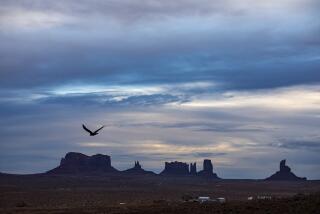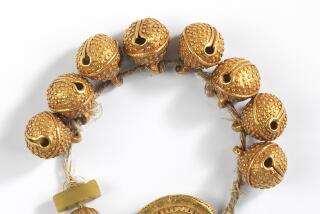Cache of Indian Artifacts Brings Delight and an Inquiry
- Share via
TAOS, N.M. — The discovery of a large cache of early Indian artifacts in a storage locker in northwestern New Mexico has delighted archeological experts who say the find is rare because the Anasazi items are in exceptional condition.
But the discovery is a matter of concern to federal investigators who believe that the items may have been looted from federal or Indian lands.
U.S. and local authorities were led to the storage locker in Bloomfield, N.M., early last month by a woman who had been arrested on a drug charge in Taos in December. They described the woman as a “digger” and trader of artifacts, and said they began to question her after finding some Anasazi items in her home.
In the locker was “box after box of items”--pottery, tools, knives and other artifacts--the majority from the Anasazi culture, said Ute Mountain Ute tribal archeologist Doug Bowman.
The Anasazi (the ancient ones) were the ancestors of the Pueblo Indians. The great Anasazi cities of Chaco Canyon and Mesa Verde flourished from about AD 700 until AD 1300 in the “four corners” region, where New Mexico, Colorado, Utah and Arizona meet. The Anasazi left for the Rio Grande Valley when their lands would no longer support their existence.
Jon Young, archeologist for the Carson National Forest in Taos, said that because the items are perishable but preserved, they had to have come from a cave or an overhang shelter. “That’s what’s exciting about this. That’s pretty damn rare.”
But Young lamented the fact that the artifacts had been taken from their original environment. “It’s like ripping the pages out of a great book. You still have the pages, but you’ve lost the book.”
Young said he did not like to put a price tag on antiquities, but surmised that they could be very valuable in Far East markets.
Special agents from the Bureau of Land Management called Bowman in from the Towaoc, Colo., reservation to authenticate the find. Bowman said he took 35 photographs with groupings of from one to 10 objects, but could not do a complete inventory because there were too many pieces.
He dated the items from the Basketmaker 3 era to the Pueblo 3 era, or from AD 700 to AD 1300. About half are pottery, ranging from three- or four-inch bowls and jars to one jar 18 inches in diameter. “One jar was definitely Chaco design,” he said.
There were also stone tools, small knives, scrapers, manos (small hand-grinding stones), and metates (large, flat grinding stones). “One metate was a very excellent example, quite large and completely intact,” Bowman said. Other artifacts included a necklace pendant, digging sticks, parts of a wooden loom, and corn and yucca foodstuffs that could be almost 1,300 years old.
“The real tragedy of the whole thing is that I doubt we will get information on where it all came from,” said Paul Williams, an archeologist for the Bureau of Land Management in Taos. The artifacts probably came from a number of different sites, he said. “It’s a heck of a collection.”
Williams agreed with Young about the removal of the items. “Once they are removed from their archeological setting, they lose a great deal of their scientific importance and what they could tell us about who made them and left them there. We know very little about prehistoric people.”
“In every culture there is only the occasional masterpiece that could be worth some money,” said Larry Frank, a Taos artifact collector and North American Indian art expert. “The whodunit issue is very disturbing. How did all this material evade the law--and is it still being pilfered?”
Artifacts on federal lands are protected under the Archeological Resource Protection Act of 1979, which prohibits distributing, selling, transporting or trading archeological materials.
Gary Olson, a Bureau of Land Management official in New Mexico, would only say that the case is under investigation. Agency officials emphasized that their investigation is preliminary and that there are legal ways of obtaining artifacts.
“There is some suspicion the artifacts might have come from Ute Mountain Ute tribal lands,” Bowman said. Asked if the Utes were concerned about possible artifact thefts, Bowman said: “Yes, they are always upset when someone comes and steals something from them.”
More to Read
Sign up for Essential California
The most important California stories and recommendations in your inbox every morning.
You may occasionally receive promotional content from the Los Angeles Times.













